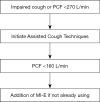Respiratory issues and current management in neuromuscular diseases: a narrative review
- PMID: 39444856
- PMCID: PMC11494593
- DOI: 10.21037/jtd-23-1931
Respiratory issues and current management in neuromuscular diseases: a narrative review
Abstract
Background and objective: Respiratory care is often embedded as a component of the overlapping management strategies in many patients with neuromuscular disease (NMD). Implementation of respiratory care strategies requires a sensitivity to the nature of the disease, the vulnerability during rapid eye movement (REM) sleep and complicating comorbidities specific to each patient. Care must adjust to progression of the disease as well as the comfort and preferences of the patient. Clinical presentations are usually heterogenous based on the specific NMD and overall course of the disease making diagnosis and respiratory care challenging. The aim of this review was to review the state-of-the-art evidence-based clinical practices and updates in the management of respiratory complications in patients with NMDs.
Methods: We conducted a search on the PubMed and Medline databases using these keywords: secretions, neuromuscular disease, neuromuscular disorders, non-invasive ventilator, neuromuscular respiratory weakness, respiratory failure. The specified timeframe began from 1980 to 2024.
Key content and findings: Timely use of non-invasive ventilation and overall respiratory care is most important as emerging evidence shows some benefits with improved mortality in this group of patients. In some settings, comorbid complications that dictate need for airway management and oral diversion may have a more profound impact on mortality than the effectiveness of ventilatory support that are chosen. A multidisciplinary team approach to care has been shown to improve the quality of life and survival in these patients in centers of excellence. Patients should have the ability to access services provided by neurology, pulmonology, speech pathology, sleep medicine, cardiology and respiratory therapy services.
Conclusions: The cornerstone for management of respiratory failure and sleep disordered breathing in NMD is non-invasive ventilation (NIV). Initiation of this support and other respiratory cares need to be timely, and patients may have very subtle symptoms during the early stages of the disease which makes it challenging in recognizing the onset of respiratory muscle stress and fatigue. Close attention to these symptoms as well as respiratory and radiologic parameters is essential for appropriate incorporation of these cares.
Keywords: Neuromuscular disease (NMD); neuromuscular respiratory weakness; non-invasive ventilation (NIV); respiratory failure.
2024 AME Publishing Company. All rights reserved.
Conflict of interest statement
Conflicts of Interest: All authors have completed the ICMJE uniform disclosure form (available at https://jtd.amegroups.com/article/view/10.21037/jtd-23-1931/coif). The authors have no conflicts of interest to declare.
Figures




Similar articles
-
Non-invasive Ventilation in Children With Neuromuscular Disease.Front Pediatr. 2020 Nov 16;8:482. doi: 10.3389/fped.2020.00482. eCollection 2020. Front Pediatr. 2020. PMID: 33330262 Free PMC article. Review.
-
Respiratory Management of Patients With Neuromuscular Weakness: An American College of Chest Physicians Clinical Practice Guideline and Expert Panel Report.Chest. 2023 Aug;164(2):394-413. doi: 10.1016/j.chest.2023.03.011. Epub 2023 Mar 13. Chest. 2023. PMID: 36921894
-
Noninvasive Ventilation and Mechanical Insufflator-Exsufflator for Acute Respiratory Failure in Children With Neuromuscular Disorders.Front Pediatr. 2020 Oct 30;8:593282. doi: 10.3389/fped.2020.593282. eCollection 2020. Front Pediatr. 2020. PMID: 33194926 Free PMC article. Review.
-
Enhancing respiratory function in neuromuscular disease: the role of non-invasive ventilation. A narrative review.Acta Myol. 2024 Jun;43(2):78-82. doi: 10.36185/2532-1900-506. Acta Myol. 2024. PMID: 39082325 Free PMC article. Review.
-
Neuromuscular Disorders in Pediatric Respiratory Disease.Clin Chest Med. 2024 Sep;45(3):729-747. doi: 10.1016/j.ccm.2024.02.021. Epub 2024 Apr 4. Clin Chest Med. 2024. PMID: 39069334 Review.
References
Publication types
LinkOut - more resources
Full Text Sources
